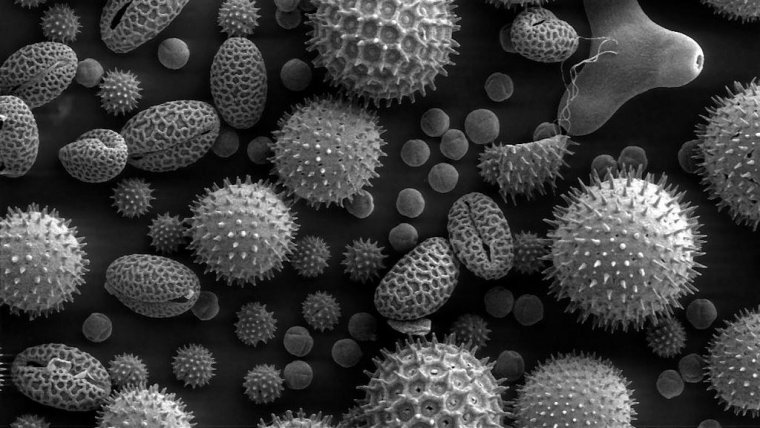| News / Science News |
Estimating how pollen particles in the atmosphere influence climate
In the past, many atmospheric scientists believed that pollen particles probably had a negligible effect on climate because they were so big. In recent years, however, as they began to realize that pollen particles were not as sturdy as they once thought, they have been rethinking their old assumptions.

Scanning electron microscope image of pollen grains from a variety of common plants. Credit: Dartmouth Electron Microscope Facility, Dartmouth College
Pollen, the same airborne material that wreaks misery during certain seasons in the form of drippy noses and itchy eyes, apparently can have an influence on weather. When big pollen particles break into fine ones, they can take up water vapor in the air to promote the formation of clouds, potentially altering weather systems as a result. Unlike greenhouse gases, which contribute to warming, these fine particles can have a cooling effect.
The impact of pollen in the atmosphere may change weather and it could change our understanding of the climate system.
Prior research indicates that when pollen becomes wet, it easily ruptures into very small particles. These small, pollen fragments could, "seed" the creation of clouds.
If you have water vapor in the atmosphere, it's hard to form droplets all by itself. But if you have a little particle already there, it's easy for water to condense on it and grow into a droplet, which enables the formation of cloud droplets.
Most people think of pollen as being pretty inert in the atmosphere, and it's not. It's interacting with the water cycle, and can influence clouds in ways that people hadn't realized before.
A team from the University of Michigan are using ground based observation data obtained from across the nation to design a computer algorithm emissions model. The model includes the different types of pollen, and takes into account various conditions that can have an effect on pollen when it enters the atmosphere, for example, rain.
Furthermore, tiny pollen particles can react with radiation. The models simulate the ability of pollen particles to interact with incoming solar radiation to understand how these particles will affect climate. By using computer models, they can estimate the effect these particles have on regional climate.
Using a cloud condensation nuclei chamber, an instrument that can reproduce the atmospheric conditions that form clouds, they were able to demonstrate that pollen can in fact grow and act as cloud droplets.
This means that pollen could have an impact on climate. One thing we are still trying to figure out is how big that effect actually is.
YOU MAY ALSO LIKE




